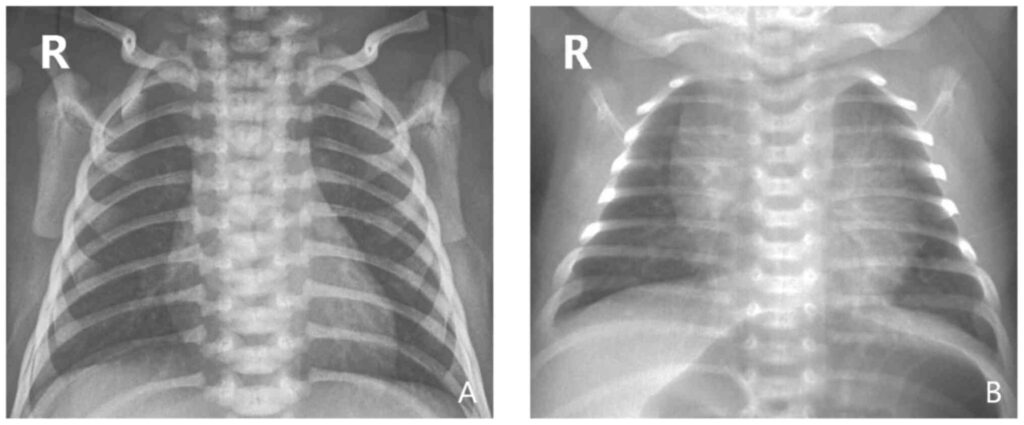Respiratory syncytial virus (RSV) is the most common cause of pneumonia and bronchiolitis worldwide in children under 1-year-old. The Center reports this for Disease Control and Prevention. The symptoms of RSV pneumonia are not specific enough; therefore, for an accurate diagnosis, a laboratory analysis is used to detect the antigen of the respiratory syncytial virus.
RSV is transmitted through the air or by contact with contaminated objects. The respiratory syncytial virus causes swelling of the nasal and pharyngeal mucosa, necrosis and exfoliation of the bronchial mucosa, inhibits the cells of the alveolar epithelium, and causes necrosis and atrophy of the alveoli.
The respiratory tract of newborns is not fully developed. They are narrow, not elastic enough, and secrete much mucus when inflamed. All this can cause oxygen deficiency during RSV infection.
Interferon for the Treatment of RSV Pneumonia: A Clinical Trial
In 2020, Chongqing Medical University assessed the safety and efficacy of interferon alfa (IFN-α) injections for treating infants younger than 28 days of age with neonatal RSV pneumonia.
The study involved 286 children in whom antibodies to the respiratory syncytial virus were found in the tracheal mucosa. All patients were full-term newborns weighing 2.5 to 4.0 kg. Infants with heart defects, immunodeficiency, and bronchial and pulmonary dysplasia were excluded from the study – these factors of severe RSV pneumonia could distort the study’s accuracy.
Patients were divided into two groups: 160 newborns received standard treatment, and 126 newborns received standard therapy + injections of interferon-alpha. Patients in both groups had similar clinical symptoms, bacterial coinfection, radiological manifestations of the disease, viral load level, age, and weight.
All patients were diagnosed with pneumonia, and in 67% of cases, an associated bacterial infection was observed in the lungs: E. coli, staphylococci, and streptococci.
Frequency of clinical symptoms:
- cough – 93% of cases;
- tachypnea – rapid breathing due to a decrease in the level of oxygen in the blood – 90%;
- blue lips – due to the decline in the level of oxygen in the blood – 68%;
- choking milk – 62%;
- wheezing – 58%.
Radiological manifestations:
- shadowing in both lungs;
- linear shadows of irregular shape;
- emphysema – an irreversible destructive expansion of the lung tissue.
Figure. Lung scans of a healthy infant (left) and an infant with RSV pneumonia (right):
Image source: https://www.spandidos-publications.com/10.3892/etm.2020.9350
During hospitalization, infants in both groups received sputum retrieval, oxygen support, antibiotic therapy for bacterial coinfection, back pats, and postural changes to improve respiratory function and were kept at a comfortable ambient temperature.
Research Result
In the group receiving additional treatment with interferon-alpha, there was a significant reduction in the duration of symptoms. However, the total length of hospital stay was reduced slightly:
| Symptom | Duration of symptom, days | |
| IFN-α + standard treatment | standard treatment | |
| Cough | 4,4 | 7,8 |
| Tachypnea | 5,2 | 6,2 |
| Milk choking | 3,9 | 5,3 |
| Blue lips | 5,1 | 6,3 |
| Wheezing | 6,5 | 7,5 |
| Duration of oxygen support | 5,6 | 6,1 |
| Hospitalization time | 9,6 | 10,3 |
In the group receiving additional treatment with interferon-alpha, two of 126 cases experienced a side effect – fever, which began approximately 2 hours after the injection. However, after a bath with warm water for 5 minutes, the temperature of the newborns returned to normal. No special treatment was required, and there were no recurrences of fever.
All patients in both groups were cured and discharged. There were no lethal outcomes.
Research Background
Referring to clinical studies, the American Academy of Pediatrics reports that RSV accounts for 76% of respiratory illnesses, while influenza accounts for only 10%. Moreover, the respiratory syncytial virus infects 90% of children under the age of 2 years. RSV does not form long-term immunity, and reinfection occurs throughout life. However, RSV is most dangerous for infants, premature babies, and children with congenital anomalies.
In 2016, an international team of scientists analyzed 5274 studies from 32 countries on the severity and mortality of respiratory syncytial virus. Scientists have received similar results: RSV is the leading cause of hospitalization and death in children under 1-year-old, especially premature ones.
Another international team of scientists clarified that for 2015 there are no specific treatments for the respiratory syncytial virus, and the primary treatment is symptomatic-supportive: oxygen support and maintaining airway patency. However, scientists are encouraging that more than ten vaccines and specific antibodies are undergoing clinical trials.
In 2019, Belgian scientists described reduced interferon-alpha production mechanisms during respiratory syncytial virus infection. The low production of IFN-α is the leading cause of acute lower respiratory tract disease in infants with RSV infection.
Also, in 2019, American scientists from the National Institutes of Health published a study that showed the critical role of type 1 interferon, to which IFN-α belongs, in fighting bacterial infection.
Conclusions
The respiratory syncytial virus is one of the infants’ most common respiratory tract infections worldwide. Interferon-alpha injections are effective in relieving the symptoms of RSV pneumonia. As a result, the duration of oxygen support is significantly reduced, the cough passes faster, and the cyanosis of the skin disappears. However, the time of hospitalization decreased slightly. In 0.6% of cases, fever is observed, quickly stopped, and without relapse.
Useful article, necessary information? Share it!
Someone will also find it useful and necessary:
Sources
- Efficacy and safety of interferon on neonates with respiratory syncytial virus pneumonia
- Respiratory Syncytial Virus Activity — United States, July 2008–December 2009
- Respiratory Syncytial Virus: Infection, Detection, and New Options for Prevention and Treatment
- A passive quantitative measurement of airway resistance using depth data
- Clinical Practice Guideline: The Diagnosis, Management, and Prevention of Bronchiolitis
- Respiratory syncytial virus hospitalization and mortality: Systematic review and meta-analysis
- Lower respiratory tract infection caused by respiratory syncytial virus: current management and new therapeutics
- Respiratory syncytial virus nonstructural proteins 1 and 2: Exceptional disrupters of innate immune responses
- IFN-mediated negative feedback supports bacteria class-specific macrophage inflammatory responses




